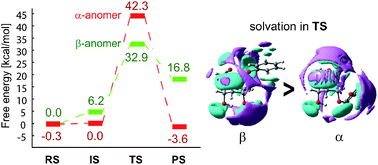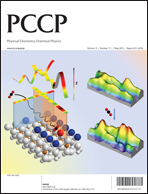One of the difficulties in application of the usual reference interaction site model self-consistent field (RISM-SCF) method to a highly polarized and bulky system arises from the approximate evaluation of electrostatic potential (ESP) with pure point charges. To improve this ESP evaluation, the ESP near a solute is directly calculated with a solute electronic wavefunction, that distant from a solute is approximately calculated with solute point charges, and they are connected with a switching function. To evaluate the fine solvation structure near the solute by incorporating the long-range solute–solvent Coulombic interaction with low computational cost, we introduced the dual solvent box protocol; one small box with the fine spacing is employed for the first and the second solvation shells and the other large box with the normal spacing is employed for long-range solute–solvent interaction. The levoglucosan formation from phenyl α- and β-D-glucosides under basic conditions is successfully inspected by this 3D-RISM-SCF method at the MP2 and SCS-MP2 levels, though the 1D-RISM-SCF could not be applied to this reaction due to the presence of highly polarized and bulky species. This 3D-RISM-SCF calculation reproduces the experimentally reported higher reactivity of the β-anomer. The 3D-RISM-SCF-calculated activation free energy for the β-anomer is closer to the experimental value than the PCM-calculated one. Interestingly, the solvation effect increases the difference in reactivity between these two anomers. The reason is successfully elucidated with 3D-RISM-SCF-calculated microscopic solvation structure and decomposition analysis of solute–solvent interaction.

You have access to this article
 Please wait while we load your content...
Something went wrong. Try again?
Please wait while we load your content...
Something went wrong. Try again?


 Please wait while we load your content...
Please wait while we load your content...